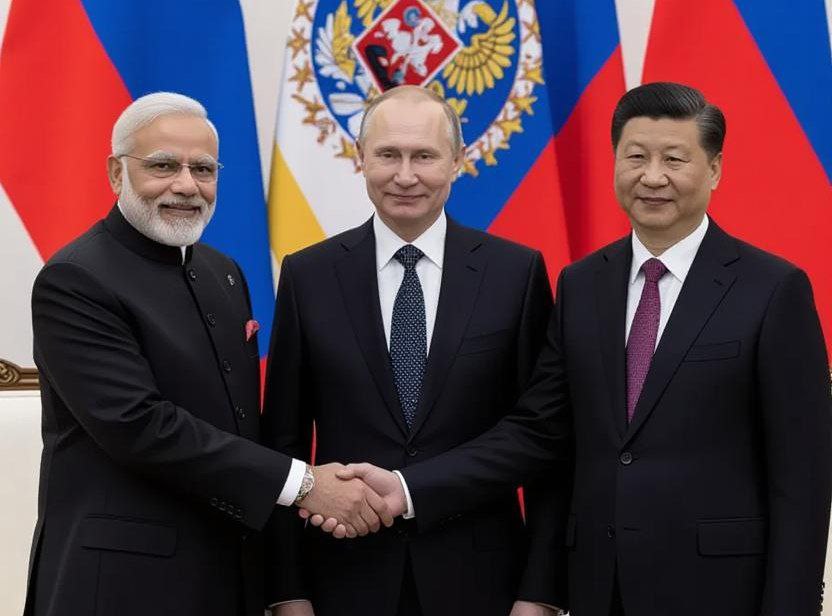The Russia-India-China (RIC) alliance, once considered symbolic, is witnessing a revival in 2025 as Donald Trump’s aggressive trade tariffs push these three powers closer. This blog explores the historical roots of RIC, the role of Trump’s policies as a catalyst, the significance of the upcoming SCO summit in Tianjin, recent India-China rapprochement, Russia’s mediation efforts, and the economic and security challenges that continue to undermine trust. Analysts view this reboot as a marriage of convenience rather than a lasting strategic partnership, raising the question: can RIC endure beyond tactical alignment?
The Russia-India-China (RIC) Reboot
The Russia-India-China (RIC) trilateral grouping, once hailed as a potential game-changer in global geopolitics, is making an unexpected return in 2025. Originally conceived in the 1990s as a counterweight to U.S. dominance, the alliance has long been more symbolic than substantive due to the deep-seated rivalry between India and China. However, shifting global dynamics—particularly Donald Trump’s tariff-heavy trade policies—are pushing these three powers to reconsider their strategic options.
Historical Context of the RIC Alliance
The RIC concept emerged in the aftermath of the Cold War as Moscow, New Delhi, and Beijing sought alternatives to U.S.-led global structures. The idea was formalized in 2002 with the intention of building multipolarity, countering sanctions, and reducing Western influence in Asia. Over the years, the grouping operated through mechanisms like the Shanghai Cooperation Organization (SCO) and BRICS. But internal distrust, particularly the India-China border disputes, kept the alliance from achieving any meaningful depth. The last leaders’ meeting under this framework took place in 2019 at the G20 summit in Osaka, Japan.
Why the 2025 Reboot?
The current revival is largely driven by external pressure, most notably Trump’s aggressive trade war. Since beginning his second term in January 2025, Trump has imposed sweeping tariffs, including a 25 percent levy on Indian exports earlier in August, followed by another 25 percent scheduled for August 27. The stated justification was India’s continued purchase of Russian oil, but New Delhi has called these measures unfair and discriminatory.
India’s frustration comes at a time when Trump has adopted a softer approach toward China, extending a temporary tariff truce despite ongoing trade rivalry. Russia, meanwhile, continues to suffer under Western sanctions amid its prolonged conflict in Ukraine, making closer ties with India and China essential for Moscow’s geopolitical survival. Against this backdrop, the SCO summit in Tianjin on August 31, 2025, has emerged as a platform for the three leaders—Modi, Putin, and Xi—to test the waters of renewed cooperation.
Trump’s Role as a Catalyst
Ironically, Trump’s tariff policies have acted as a unifying force for the RIC powers. India feels unfairly singled out, especially when China, the largest buyer of Russian crude, has faced less severe penalties. Russia, isolated and weakened, is eager to re-establish relevance by pushing for greater trilateral coordination. China, while cautious, sees strategic value in pulling India closer at a time when Washington’s reliability as a partner is in doubt.
The SCO Summit: A Stage for Diplomacy
The upcoming Tianjin summit is expected to be pivotal. Modi’s participation marks his first visit to China since 2018, a gesture symbolizing cautious rapprochement. Russia has been strongly advocating for a trilateral meeting within the summit framework to formalize a response to U.S. policies.
Recent India-China engagements have added momentum. In October 2024, the two sides reached an agreement on patrolling along their disputed border, de-escalating tensions that had peaked after the 2020 Galwan Valley clash. This agreement opened the door to restored direct flights, eased visa restrictions, and the reopening of border trade posts. Economic pragmatism has also softened tensions, as bilateral trade rose to $118.4 billion in 2023-24, with India heavily reliant on Chinese raw materials for its electronics and pharmaceutical sectors. Proposals to reduce scrutiny on Chinese investments in Indian manufacturing suggest that New Delhi is recalibrating its stance in the face of U.S. tariffs.
Russia’s role has been that of an advocate and mediator. Foreign Minister Sergey Lavrov has repeatedly emphasized the importance of reviving RIC, presenting it as a necessary counterweight to Western dominance.
Economic and Security Challenges
Despite the momentum, the RIC reboot faces formidable hurdles. Economically, disparities are glaring. China’s economy overshadows both India and Russia, while India remains dependent on the U.S. for markets and technology. In 2024, India’s exports to the U.S. stood at $77 billion, compared with $68.7 billion to Russia and even less to China. Russia, crippled by sanctions, is increasingly the junior partner in this arrangement.
Security issues are equally challenging. The 3,488-km undemarcated Line of Actual Control between India and China remains a flashpoint. Historical animosities, including the 1962 war and the Galwan clash, continue to erode trust. China’s strategic closeness to Pakistan is another sticking point. During a brief India-Pakistan conflict in May 2025, Pakistan deployed Chinese-made jets, underscoring Beijing’s role as Islamabad’s most reliable defense partner—something that New Delhi cannot ignore.
Analysts’ View: A Marriage of Convenience
Experts widely describe the RIC revival as a tactical alignment rather than a genuine strategic partnership. For India, the shift is largely a response to U.S. pressure, not a long-term commitment to siding with China and Russia. For Russia, the grouping offers a lifeline amid isolation, while for China, it provides leverage over both India and the United States. The lack of trust, especially between India and China, makes deep cooperation unlikely.
Michael Kugelman and other analysts argue that India-China ties remain fragile, with strategic competition far outweighing shared interests. The China-Pakistan nexus remains a critical obstacle, and India’s membership in the Quad signals that its long-term trajectory is still aligned with Washington.
The Road Ahead
The SCO summit in Tianjin will be a litmus test for whether the RIC framework can evolve beyond symbolism. In the short term, cooperation may allow the three countries to push back against Trump’s tariffs, diversify trade, and project strength through platforms like BRICS and SCO. But in the long term, deep-rooted mistrust, economic imbalances, and competing security interests will likely prevent the RIC from becoming a transformative alliance.
In essence, the RIC reboot of 2025 looks less like the birth of a new geopolitical order and more like a marriage of convenience—an arrangement born of necessity, vulnerable to collapse once external pressures ease. Its endurance will depend not only on Trump’s trade policies but also on whether India and China can reconcile their differences, something history suggests will be far easier said than done.
Disclaimer:
This article is for informational and analytical purposes only. It is based on publicly available reports, expert opinions, and recent geopolitical developments. The views expressed do not represent any government, institution, or political entity. Readers are advised to interpret the information within the context of ongoing global events.

